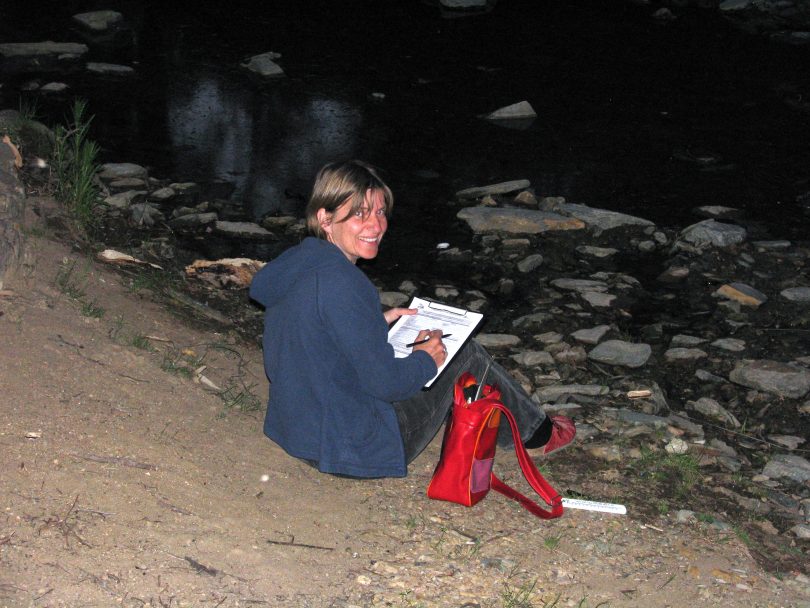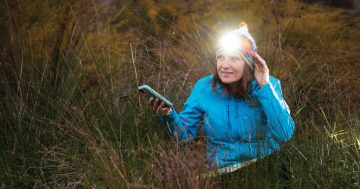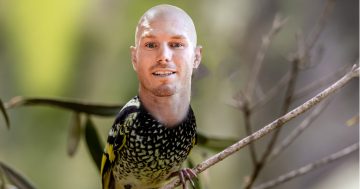
Frogs may be out of sight but they should not be out of mind. Photo: Supplied.
Funding is drying up for a key environmental and citizen science group which fears it may not be able to continue its vital research.
Frogs may not be as visible as big native birds or furry mammals but as the environmental ‘canaries in the mine’ they can sound a warning of potential threats to the natural world humans and other species rely on.
Frogwatch ACT, which operates under the auspices of the Ginninderra Catchment Group, has been monitoring the ACT’s frog populations for years, but its growth and a change in the funding model has the organisation and its army of volunteers worried. This comes after it lost funding three years ago when the Commonwealth Caring for Country program was axed.
Co-ordinator Anke Maria Hoefer, who only a few weeks ago won the ACT Government Environment Community Support Award at the ACT Landcare Awards for her work with Frogwatch, said the organisation faced an uncertain future and her core funding of just $20,000 a year was simply not enough to maintain the program.
“The program has grown so big and there are all-year-round demands and projects. If we don’t get that core funding and much more than we have currently, I can’t run the program,” she said.
Ms Hoefer said the catchment groups were vital because they were the stepping stone between the Government and the people on the ground conducting research.
The ACT Government doesn’t conduct any frog research itself and relies on Frogwatch and its volunteers to provide data which feeds into its planning work.
Ms Hoefer said ANU scientists would soon be analysing data from this year’s frog census. Two years ago, Frogwatch provided the Government with a report on the habitat preferences of frogs in the ACT that included management recommendations, some of which were adopted.

Anke Maria Hoefer on the job for Frogwatch at Bradleys Creek. Photo: Supplied.
Frogwatch has submitted its budget request and Ms Hoefer will be meeting Ministers this week to discuss the program but she believes the Government should already be aware of Frogwatch’s importance.
Catchment groups featured prominently at the awards ceremony where Minister for the Environment and Heritage Mick Gentleman officiated.
“Mr Gentleman must realise we are doing such an amazing job but it’s not necessarily translating into dollars,” Ms Hoefer said.
She said some see Frogwatch as a symbol of community enagagement, like a song and dance, but it was a fully fledged scientific program.
For the last three years, it has been running climate change projects in which volunteers have gone out to dedicated sites once a week for six to seven months.
“It’s a huge commitment from volunteers,” she said.
The data will be analysed and compared with data from the 1980s and 90s, and the signs are not good with frogs these days calling six weeks earlier due to less reliable winter rain and warmer temperatures.
Climate change and development pressures are all taking their toll on the ACT’s frogs, which also recently suffered from a fungal disease that affected populations world-wide.
There are now about nine common species left in the ACT, and Ms Hoefer expressed relief at the recent heavy rain which should help replenish populations after a dry winter.
Ms Hoefer, who has been working with the developer behind the Ginninderry project in West Belconnen, said strings of ponds needed to be maintained so there was connectivity, more ground cover was needed and water quality must improve.
The ACT’s wetlands program was a good idea but suffered from a lack of follow-up, with the Belconnen wetlands overgrown with weeds and full of rubbish.
After heavy rain, ravenous mosquito fish are flushed into them, devouring tadpole populations.
Ms Hoefer said frogs were an indicator species of environmental health, because they had an aquatic and land stage of life.
“Whatever goes wrong in water and on land they are greatly affected. Because they have no hard eggshell, everything goes into their eggs, and on land, they have a permeable skin so all the pollution goes straight into their body,” she said.
“They show us straight away when that happens.”
Ms Hoefer welcomed news of a new FrogID mobile phone app released last month by the Australian Museum, which can identify species by their calls.
“Generally it’s a fantastic thing, you don’t need to know anything about frogs, you just feed the data in,” she said.

















